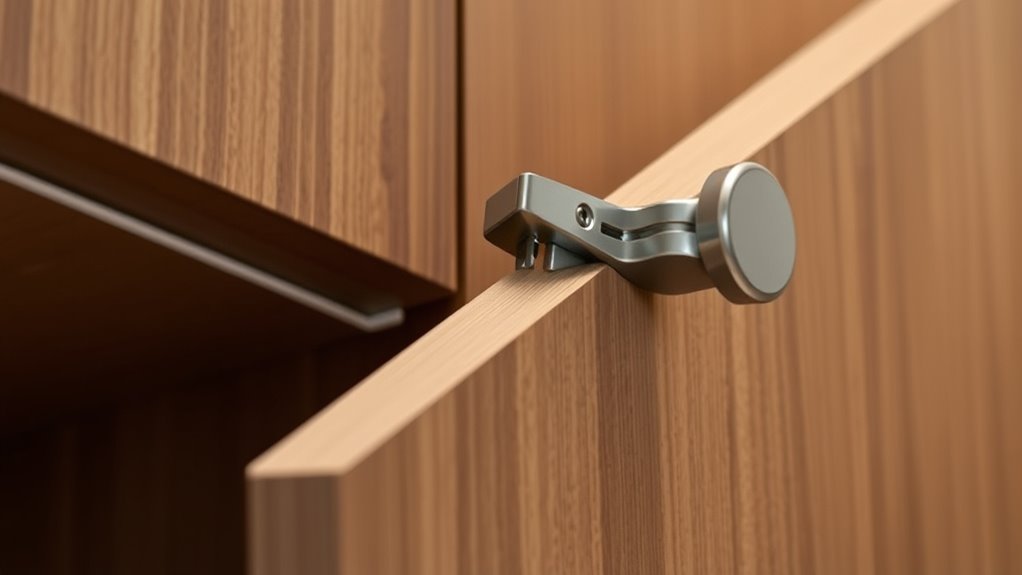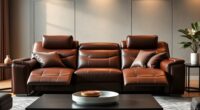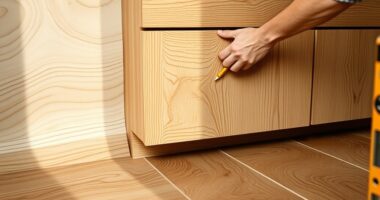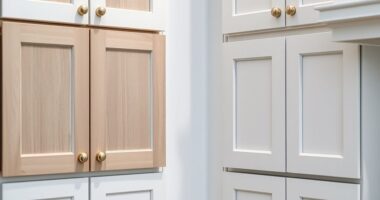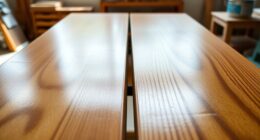To achieve perfect alignment with soft-close hardware, start by inspecting your hinges and adjust their screws incrementally, shifting doors or drawers for a smooth fit. Fine-tune the damping mechanism by turning its adjustment screw gradually, testing closure after each change to find the right balance. Remember to keep adjustments small and precise to prevent damage and ensure longevity. If you want to master these tips, there’s more to explore to perfect your setup.
Key Takeaways
- Inspect hinges for misalignment and adjust screws incrementally to ensure smooth, gap-free door or drawer closure.
- Use adjustment screws to align doors vertically and horizontally for a perfect fit with adjacent surfaces.
- Locate damping adjustment screws or dials; turn gradually to calibrate closing force and speed.
- Test closure after each adjustment to achieve gentle, quiet operation without slamming or sluggishness.
- Make small, precise tweaks and repeat testing to fine-tune soft-close performance and prevent hardware wear.
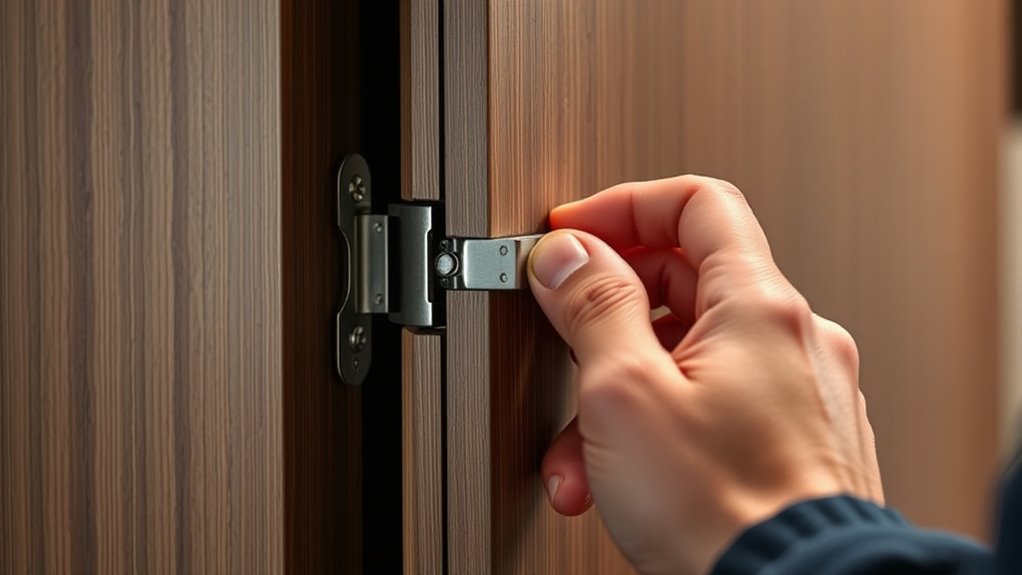
Soft-close hardware tuning is essential for guaranteeing smooth and quiet door and drawer operation in your home or workspace. When your furniture isn’t functioning properly, it can be frustrating, but with a few simple adjustments, you can restore perfect alignment and performance. The key to achieving this lies in proper hinge adjustment and damping calibration, both of which are critical to the smoothness and silence of your soft-close mechanisms.
Begin by inspecting your hinges. If a door or drawer isn’t closing fully or is misaligned, it’s time to perform hinge adjustment. Most soft-close hinges have adjustment screws that allow you to fine-tune the position of the door. Turning these screws clockwise or counterclockwise shifts the door slightly inward, outward, or vertically, helping you align it perfectly with adjacent surfaces. Make small, incremental adjustments, test the closure, and repeat as necessary until the door closes smoothly without gaps or sticking. Proper hinge adjustment ensures that the soft-close function operates without resistance or misalignment, reducing wear and tear over time.
Inspect hinges and make small adjustments to ensure smooth, aligned soft-close operation.
Next, focus on damping calibration. Damping is what controls the speed and force with which the door or drawer closes. If it closes too quickly, it can slam shut, causing noise and potential damage; if it’s too slow, you might experience frustration or difficulty in closing the item fully. To calibrate damping, locate the damping adjustment screw or dial—usually found on the soft-close mechanism itself. Turn it gradually to increase or decrease damping force. Test the door or drawer after each adjustment, observing how it closes. The goal is to find a balance where it closes gently and quietly, without slamming or feeling sluggish.
It’s important to be precise during damping calibration. Over-adjusting can lead to sluggish closures or excessive force, which may wear out the hardware prematurely. Under-adjusting might not provide the quiet, smooth operation you desire. Take your time, make small adjustments, and always test after each change. Remember, a well-calibrated damping system not only prolongs the lifespan of your soft-close hardware but also enhances comfort and safety. Additionally, understanding the practical principles behind soft-close mechanisms can help you troubleshoot and maintain optimal performance over time.
Frequently Asked Questions
Can Soft-Close Hardware Be Adjusted on All Types of Cabinet Hinges?
No, soft-close hardware can’t be adjusted on all types of cabinet hinges. Your ability to make adjustments depends on hinge compatibility and the specific design. Some hinges have built-in adjustment features, while others have adjustment limitations or none at all. Check your hinge type first. If it’s compatible, follow the manufacturer’s instructions carefully. If not, you might need to replace the hinges with soft-close compatible ones for proper adjustment.
How Often Should Soft-Close Mechanisms Be Recalibrated for Optimal Performance?
You should recalibrate your soft-close mechanisms every 6 to 12 months, depending on usage. Following a regular maintenance schedule ensures they stay aligned and function smoothly. If you notice frequent misalignment or noise, it’s time for an adjustment sooner. Consistent calibration frequency helps prevent wear and tear, extending the lifespan of your hardware and maintaining peak performance. Regular checks keep your cabinets closing softly and quietly.
Are There Safety Concerns When Tuning Soft-Close Hardware?
Are you aware of potential safety concerns when tuning soft-close hardware? While safety precautions like wearing gloves and ensuring the hardware is compatible are essential, improper adjustments can cause pinched fingers or hardware failure. Always double-check compatibility before tuning, and follow manufacturer instructions closely. Do you think taking these steps makes your adjustments safer? Proper tuning minimizes risks, helping you enjoy smooth, safe closing mechanisms without worry.
What Tools Are Recommended for Fine-Tuning Soft-Close Hinges?
You’ll want to use a Phillips screwdriver and a hinge adjustment tool for fine-tuning soft-close hinges. These tools help you achieve proper hinge alignment and soft close calibration, ensuring smooth operation. A small level can also be useful to check alignment visually. Carefully turn the adjustment screws, testing the hinge’s closing action after each turn, until the soft-close feature operates perfectly and the door aligns correctly.
Does Adjusting Soft-Close Hardware Affect the Warranty?
Adjusting soft-close hardware typically doesn’t void your warranty if you follow the manufacturer’s adjustment guidelines. While some worry about warranty implications, proper adjustments enhance performance without risking coverage. Just make certain you use recommended tools and avoid forcing the hinges, as improper adjustments could cause damage. Always check the specific warranty terms, but generally, careful tuning is safe and can improve your soft-close mechanism’s lifespan.
Conclusion
By fine-tuning your soft-close hardware, you guarantee smooth operation, precise alignment, and reliable performance. Adjust the hinges for a seamless closing, calibrate the dampers for consistent control, and double-check the alignment for perfect fit. With these simple steps, you create a quiet, effortless closing every time. Embrace these adjustments to enhance durability, improve aesthetics, and enjoy the satisfaction of a perfectly functioning piece. Because, when your hardware works flawlessly, your furniture feels just right.
